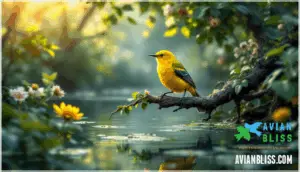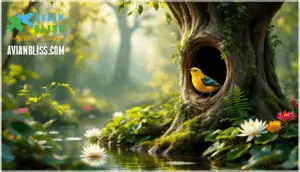This site is supported by our readers. We may earn a commission, at no cost to you, if you purchase through links.

With populations down 40% since the 1960s as wetlands vanish, this striking cavity-nester has become both an indicator species for ecosystem health and a conservation priority, yet most birders outside its range have never glimpsed one in the wild.
Table Of Contents
- Key Takeaways
- What is The Prothonotary Warbler?
- How to Identify a Prothonotary Warbler
- Where Do Prothonotary Warblers Live?
- Breeding, Nesting, and Feeding Habits
- Conservation Status and Ongoing Efforts
- Frequently Asked Questions (FAQs)
- Is a Prothonotary Warbler rare?
- What is the difference between a yellow warbler and a Prothonotary Warbler?
- Where can I find a Prothonotary Warbler?
- Where do prothonotary warblers nest?
- What is the scientific name of the Prothonotary Warbler?
- How long do Prothonotary Warblers live in the wild?
- What adaptations help the Prothonotary Warbler survive in its habitat?
- What is the Prothonotary Warblers role in the ecosystem?
- How can birdwatchers attract Prothonotary Warblers to their backyard?
- What predators threaten Prothonotary Warbler populations?
- Conclusion
Key Takeaways
- The Prothonotary Warbler stands out as one of only two eastern warbler species that nests in cavities rather than building traditional cup-shaped nests in branches, thriving exclusively in flooded forests and wooded wetlands where most warblers won’t venture.
- Populations have crashed by 40% since the 1960s due to wetland habitat loss, with catastrophic declines in some regions like southern Ontario where breeding pairs dropped from 40 to just 8 between 1995 and 2005.
- This species serves as a critical indicator of wetland ecosystem health, facing combined threats from habitat fragmentation, aggressive nest competition from House Wrens, and Brown-headed Cowbird brood parasitism that can reach 40% in fragmented forests.
- Conservation efforts including nest box programs, wetland restoration, and federal protections under the Migratory Bird Treaty Act have shown measurable success, boosting fledging rates to 60% in monitored sites where birders and landowners actively participate.
What is The Prothonotary Warbler?
If you’ve ever wondered what makes the Prothonotary Warbler stand out among North American songbirds, you’re about to find out. This golden wanderer breaks the mold in ways that matter—from its unusual name to its cavity-nesting lifestyle.
Let’s explore what defines this species, where its striking name comes from, and what makes it truly unique among warblers.
Species Overview and Classification
Taxonomically, this Passeriformes member belongs to Parulidae, the New World warbler family. Its classification reflects distinct species traits absent in most eastern warblers—primarily cavity-dependent reproduction.
Consider these defining characteristics:
- Order: Passeriformes (perching birds with specialized vocal apparatus)
- Family: Parulidae (wood-warblers endemic to the Americas)
- Genus: Protonotaria (monotypic, containing only this species)
- Conservation Status: Least Concern under IUCN assessment
- Phylogenetic Position: Divergent from typical foliage-nesting warbler lineages
Warbler comparison studies highlight its ecological separation from congeners through nesting behavior alone.
Etymology and Naming History
Louisiana Creoles coined its name in the late 1700s, noting how its striking yellow plumage mirrored the saffron robes worn by papal prothonotaries—high-ranking Catholic Church scribes. Comte de Buffon first documented "Le figuier protonotaire" in 1779, followed by Pieter Boddaert’s formal designation, Motacilla citrea, in 1783. Spencer Baird later established the genus Protonotaria in 1858, cementing today’s scientific nomenclature. Yet early ornithologists like Audubon and Wilson offered no etymological clarity, leaving the church-robe connection as enduring folklore rather than documented fact.
The Prothonotary Warbler’s name traces to 18th-century Louisiana Creoles who saw papal court robes in its golden plumage, though ornithologists never confirmed this folkloric connection
The Prothonotary Warblers’ breeding habitat characteristics are essential for their survival and nesting.
| Language | Common Name | Latin Origins |
|---|---|---|
| English | Prothonotary Warbler | Protonotaria citrea |
| Spanish | Reinita Protonotaria | "citrea" = lemon-yellow |
| French | Paruline orangée | protonotarius = high clerk |
Historians still debate whether Louisiana tradition inspired the name or if later observers rationalized it post-classification—an unresolved puzzle in warbler taxonomy.
Unique Features Among Warblers
While most warblers weave cup-shaped nests in tree branches, the Prothonotary stands apart as one of only two eastern species that nests in cavities—a behavior it shares with Lucy’s Warbler but perfected in its own watery domain.
You’ll recognize its striking golden feathers instantly, a beacon among swamp shadows where tree holes provide shelter above standing water.
This cavity-nesting habit, combined with its bright plumage and affinity for flooded forests, makes warbler identification straightforward even for newcomers to ornithology.
How to Identify a Prothonotary Warbler
You’ll spot this golden beauty in the swamps if you know what to look for. The field marks are straightforward—bright plumage, distinct size, and a voice that cuts through the wetland chorus.
Let’s break down the key identification features that separate this warbler from the rest.
Distinctive Plumage and Physical Traits
If you’ve ever wondered what makes the Prothonotary Warbler look like a ray of sunlight trapped in feathers, it’s the bird’s stunning golden-yellow head and breast that seem to glow against blue-gray wings—a color combination so vivid it stops birders in their tracks.
You’ll recognize this Wood Warbler by these key physical traits:
- Feather coloration: Rich golden-yellow on the head and underparts
- Wing morphology: Blue-gray flight feathers creating sharp contrast
- Tail features: White spots visible on the outer tail feathers
- Beak structure: Large, relatively long bill for a warbler
- Plumage patterns: White undertail coverts completing the distinctive look
These characteristics make bird identification straightforward once you’ve spotted one in its swampy habitat.
Differences Between Males and Females
Though males and females share the same golden glow, she wears a softer, more understated version of his radiant plumage—like a watercolor compared to his oil painting. Color differences are most noticeable in breeding pairs, where her golden-yellow appears muted and less saturated.
Despite these distinctions in bird identification, both sexes play essential roles in mating behaviors. There is no significant gender size variation affecting their warbler habitat use or species conservation status in avian conservation efforts.
Song and Vocalizations
You’ll hear him before you see him—a loud, ringing "tweet-tweet-tweet-tweet" that carries through the swamp like a bell chiming over still water. His acoustic signals are distinctive and repetitive, making bird calls easier to identify than other bird species in warbler habitat.
Listen for:
- Loud, monotone notes without complex melody structure
- Consistent rhythm resembling metallic ringing
- Limited vocal learning compared to other warblers
- Simple song patterns repeated throughout territory
- Calls that aid ornithological research and avian conservation
Where Do Prothonotary Warblers Live?
If you want to track down a Prothonotary Warbler in the wild, you’ll need to know where these golden warblers make their home. Their habitat preferences are surprisingly specific, tying them to wetland ecosystems most other warblers avoid.
Let’s explore the landscapes, regions, and seasonal movements that define this species’ range.
Preferred Habitats and Ecosystems
You won’t find this golden jewel perched in dry upland forests—the Prothonotary Warbler thrives where water and wood converge, making its home in environments most warblers avoid.
These specialists favor wooded wetland habitats like flooded bottomland forests, swamps, and riverine systems where slow-moving water meets mature trees.
You’ll spot them in freshwater wetlands with standing snags, beaver ponds, and along stream corridors—ecosystems where wetland ecology and forest dynamics create the perfect stage for their unique lifestyle.
Geographic Distribution and Range
Breeding Grounds span a vast swath of eastern North America, stretching from the Southeast to the upper Mississippi Valley. You’ll encounter Prothonotary Warblers across:
- Eastern Minnesota and Wisconsin east to southern New York
- South through the Southeast to east-central Texas and central Florida
- Louisiana, hosting roughly 25% of the global breeding population
- The Atchafalaya Basin alone, sheltering 5% of all breeding birds
- Southwestern Ontario’s dwindling deciduous swamp forests in Canada
Range Maps reveal alarming Range Shifts—Habitat Loss has contracted their distribution markedly since the late 19th century. Conservation efforts focus on protecting warbler habitats to stabilize the population.
Seasonal Migration Patterns
When autumn’s chill triggers their departure, these golden warblers begin a journey spanning thousands of miles, trading North America’s swamps for the steamy mangroves of Central and South America. Migration Routes follow the Gulf Coast Flyway Patterns, with Stopover Sites dotting the Caribbean islands.
Spring Arrival peaks in late March through early April, when you’ll witness the return of these cavity nesters to their breeding territories, completing one of avian migration’s most extraordinary cycles.
Breeding, Nesting, and Feeding Habits
The Prothonotary Warbler breaks from typical warbler norms by nesting in tree cavities, a behavior that shapes its entire breeding season.
Understanding how these birds forage, reproduce, and raise their young reveals the intricate balance they maintain in swampy woodlands. Let’s examine their nesting preferences, feeding strategies, and reproductive patterns.
Nesting Behavior and Cavity Preference
Unlike most warblers that tuck their nests into branch forks or shrubs, Prothonotary Warblers break the mold by claiming cavities—holes in trees, stumps, or even nest boxes—as their breeding strongholds.
Males establish breeding territory through vocal displays, then inspect multiple tree hole options for nest site selection. Once a female accepts his cavity-nesting proposal, she fills the hollow with moss, leaves, and twigs, weaving nesting materials into a soft cup lined with rootlets—a vital adaptation for habitat preservation.
Diet and Foraging Techniques
With their nest secured, these golden warblers spend their days hunting through the swamp canopy, plucking aquatic insects from moss-covered logs and probing bark crevices with their stout bills. Their aquatic feeding strategies reflect essential wildlife ecology principles:
- Foliage gleaning insects and larvae from waterside vegetation
- Seed consumption and nectar during warbler migration periods
- Insect foraging along tree trunks, nuthatch-style
This nesting nutrition approach sustains both breeding success and avian ecology balance.
Mating, Parental Care, and Reproduction
Males court females through aerial displays and persistent singing, then guide them to several potential nest sites—a real estate tour through the swamp canopy where she makes the final choice. She alone constructs the nest and incubates 4-6 eggs for roughly two weeks, while he defends their territory.
Both parents feed nestlings for about 11 days, though brood survival faces threats from species decline factors affecting avian ecology throughout warbler migration routes.
Conservation Status and Ongoing Efforts
The golden warbler’s future isn’t as bright as its plumage, and understanding the pressures it faces helps you see why action matters.
From shrinking swamplands to unwelcome nest invaders, several factors threaten this cavity-nesting species.
Here’s what’s happening to prothonotary warbler populations and what you can do about it.
Population Trends and Threats
Over recent decades, Prothonotary Warbler populations have experienced significant species decline, with numbers plummeting approximately 40% across North America since the 1960s. This population decline reflects both habitat loss in forested wetlands and additional environmental impacts such as nest predation, brood parasitism, and insecticide use.
In Canada, the situation demands urgent conservation efforts—populations dropped from 40 pairs to just 8 between 1995 and 2005, illustrating the critical need for thorough threat analysis and wildlife conservation strategies to guarantee species survival.
Impact of Habitat Loss and Brood Parasitism
Habitat loss and brood parasitism form a devastating one-two punch for Prothonotary Warbler populations. Southern Ontario’s wetlands shrank by 61% since European settlement, eliminating prime nesting grounds.
Habitat fragmentation then invites aggressive House Wrens and Brown-headed Cowbirds into remaining territories. Nest predation reaches 40% in fragmented Ontario forests, while parasitized broods produce underweight chicks with lower survival odds, compounding population decline.
Conservation Strategies and Legal Protections
Protection under federal law gives you a fighting chance to reverse decades of decline. The Migratory Bird Treaty Act shields Prothonotary Warblers from direct harm, while Canada’s Species at Risk Act designates them as Endangered, triggering mandatory habitat restoration and species protection measures. Conservation biology strategies now span borders:
- Wetland conservation through New York’s Freshwater Wetlands Act protects breeding sites over 7.4 acres by 2028
- Environmental policy coordination via Partners in Flight tackles the 53% population crash in the Lower Mississippi Valley
- Bird sanctuary networks and artificial nest box programs boost fledging success to 60% in monitored Ontario sites
- Ecosystem management initiatives target mangrove preservation across wintering grounds in Mesoamerica
Despite these efforts, habitat loss and insufficient protections in some regions demand continued adaptive management.
How Birders and Landowners Can Help
You can make a tangible difference right from your own backyard, whether you’re mounting a nest box or simply keeping records of what you see.
Habitat restoration through native plantings and bird-friendly practices strengthens conservation status. Nest box installation boosts nesting success, while community engagement and conservation partnerships enhance wildlife preservation.
Report sightings to citizen science projects—your observations drive bird conservation efforts targeting critical habitat needs.
Frequently Asked Questions (FAQs)
Is a Prothonotary Warbler rare?
Birds of a feather flock together," but this golden gem stands apart in dwindling numbers. Population trends show species decline driven by habitat loss, though conservation efforts maintain its IUCN status as Least Concern.
Habitat preservation is critical for bird conservation.
What is the difference between a yellow warbler and a Prothonotary Warbler?
Plumage comparison reveals key differences: Yellow Warblers show uniform olive-yellow tones with rusty breast streaks, while Prothonotary Warblers display bright golden heads contrasting with blue-gray wings.
Habitat overlap occurs minimally; Prothonotary Warblers prefer swampy woodlands, whereas Yellow Warblers inhabit shrubby edges and gardens.
Where can I find a Prothonotary Warbler?
Like golden sparks in shadowed canopies, these warblers light up the Southeast’s swamps and flooded bottomland forests.
You’ll find them in wooded wetlands with standing water—river bottoms, beaver ponds, and coastal regions where mossy logs meet slow-moving streams.
Where do prothonotary warblers nest?
These warblers select tree cavity nest sites in swampy bottomlands, often 5-10 feet above standing water.
Females weave nesting materials like moss, leaves, and rootlets inside natural holes or nest boxes within breeding territories.
What is the scientific name of the Prothonotary Warbler?
The scientific name isn’t just a label—it’s your key to unlocking global ornithology research and warbler genetics worldwide. Protonotaria citrea stands as the sole species in its genus, reflecting unique taxonomy details within avian ecology and behavior studies.
These studies are focused on warbler migration patterns and wildlife preservation.
How long do Prothonotary Warblers live in the wild?
Avian mortality and wildlife longevity remain challenging to quantify precisely, but banding studies suggest these warblers generally survive 3 to 5 years under natural conditions, though aging factors and survival rates vary considerably across populations.
What adaptations help the Prothonotary Warbler survive in its habitat?
Cavity-nesting strategies and specialized foraging techniques set this species apart. Its adaptation mechanisms include using tree holes near water for breeding and nesting habits.
Additionally, it employs unique survival tactics, such as foraging on driftwood for aquatic insects, perfectly matching its ecological niche in wetland habitat preferences.
What is the Prothonotary Warblers role in the ecosystem?
In nature’s grand tapestry, everything’s connected. These warblers control insect populations, acting as vital ecosystem engineering agents within the food web.
They support nutrient cycling and biodiversity conservation by transporting invertebrates through wetland food chains, maintaining their ecological niche while contributing to habitat preservation and wildlife preservation efforts.
How can birdwatchers attract Prothonotary Warblers to their backyard?
Attracting warbler species to wildlife habitat starts with creating the right conditions. Install nesting boxes near water features, plant bird-friendly plants, and guarantee food sources like aquatic insects thrive to support prothonotary warbler nesting behaviors and wildlife preservation.
What predators threaten Prothonotary Warbler populations?
Raiding a nest like bandits on a stagecoach, snakes and raccoons devour eggs and chicks. Hawk attacks target adults in flight.
Brown-headed Cowbirds practice brood parasitism, laying eggs in warbler nests—a threat demanding species protection and management through wildlife preservation and conservation.
Conclusion
Like a single candle in shadowed hollows, the prothonotary warbler illuminates what we stand to lose when wetlands disappear. Your attention to this cavity-nesting specialist—whether through nest box programs, habitat restoration, or simply learning its golden silhouette—directly influences its survival.
The swamps that cradle these birds aren’t empty wastelands; they’re living systems where adaptation meets vulnerability. Every flooded forest you protect becomes a stronghold, every sighting you report adds data to conservation efforts that refuse to let this brilliance fade into memory.









